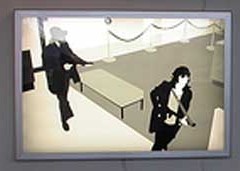
Yellow House # 2, 2001, oil on canvas, 120 x 120 in., Courtesy of Pace Wildenstein, NY, in Alex Katz in Maine, at PAFA
Alex Katz in Maine, the show of 40-some odd of his Maine paintings at the Pennsylvania Academy of the Fine Arts, has a strange tension between the portraits, which have a coloring-book/billboard quality, and the nature pictures, which mostly–but not exclusively–focus on gesture (well, at least self-conscious, reductive Katzian gesture). The work is mannered, more about style than about the content. (Sorry, but I’m tired of running images of the kid with the fish and the beach bodies; nothing I wanted to write about is available for a visual).
Exceptions
The most notable exceptions were the charming aluminum cut-outs.
“Cow,” a cow cutout at the entrance is among the most charming works in the show, a sort of spoof of the cutout roadside-attractions signs of cowboys or dinosaurs or petting zoos. The details of the fragile grass poking above the edge is a carefully observed choice. In this, the flat coloring-book painting style is a good fit, a match for the signs being spoofed. An identical cow inside the gallery loses some of its zing because it no longer is functioning as a sign, but rather as a sculpture. The cutout approach also works for the portrait of his son showing off a fish trophy, a symbol of male accomplishment at the same time that it’s a sign for fishing and summer pleasures. But you already know this if you read artblog Intern Caitlin’s report.

Black Brook 7, 1989, oil on linen, 72 x 96 in.
Collection of the artist
I did enjoy some of the paintings, some for their light and shadow, some for their focus on color and balance, some for their translation of nature’s gestures into flattened heiroglyphics. I am thinking here of Yellow House, 9 p.m., and Black Brook 7. Yellow House had the unexpectedly child-like arrangement of shingles on the side of the house as well as the areas of lit-up sunshine. 9 p.m. seemed to be about a fabulous shade of night-sky blue as well as the balancing of nature and man-made structure and light. The flattened leaves and arching branches of Black Brook 7 show Asian influence as well as some humor in the unexpected shapes of the leaves when rendered flat.
THE BIG LIFESTYLE
But the portraits and group scenes have a chilly disconnect, the people portrayed as fashion models self-consciously displaying their cool and their togs.
Ace Airport’s two women and the plane have totally fallen out of my visual memory, but the lip-shaped clouds, which seem to refer to Man Ray’s Heure de l’Observatoire, were alive with strangeness, thank goodness. I guess I think all people are strange in some way, and if all we get are people who do not seem strange, then they are posing, boring, and searching for conformity (in fashion and in life).
Isleboro Ferry Slip shows a man and woman on a ferry dock. The main interest is the contrast between the man’s self-image and the woman’s. He is dressed in city clothes–a perfectly appointed camel-and-white striped sport shirt beneath a camel sport jacket. He’s got fabulous hair, a cascade of loose brown curls, some strands casting shadows on his face. She on the other hand is dressed in Maine vacation clothes–jeans, a light-blue t-shirt with a dark blue band around the neck, a functional light blue jacket. Her hair is sun-bleached and straight and a little stringy around the edges, not much style here. Perhaps she is meeting him and he’s just arrived for the weekend. The painting seems like an advertisement for a LIFESTYLE. Frankly, Fairfield Porter did it better–those paintings offer visual charm as well as lifestyle.
The two things I remember most clearly about a talk that Katz gave at the University of Pennsylvania was 1)his ambition for the BIG gesture, the BIG painting, the BIG art and 2)his desire to make paintings that do not look like dishrags (his word) next to the work of someone else. Good, profound, thoughtful–these were not words he bandied about.
Time has not been kind to the BIG LIFESTYLE; the images look hackneyed after so many advertisements, Tina Barney photos, etc.
Without Alex Katz there might not be an Elizabeth Peyton. You might regard that as a sure reason to give Katz a gold medal, if you like. But vapid faces disconnected to anyone but themselves does not lend to profound statements. Even in the attempts to translate something about nature into simplified gestures of paint, I see merely an interest in the surface of things. But the self-portrait of only his head above the lake water, reveals an unaccustomed humility and vulnerability. Oh, he’s still in the center of the action (I do think Katz’s work is all about himself), but without the LIFESTYLE. He looks nearly naked.








